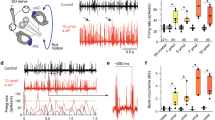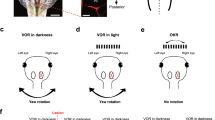Abstract
The aim of this paper was to characterise the conditions under which the quick phase of vestibular nystagmus is generated in response to sinusoidal horizontal angular accelerations in guinea pig and to determine whether the characteristics of the quick phase are altered following unilateral vestibular deafferentation (UVD). In experiment 1, the quick-phase response to 2-Hz sinusoidal stimuli with different peak head velocities was measured before and after UVD. In experiment 2, lower-frequency stimuli with a fixed amplitude (±20°) were used to measure the eye-movement response. In experiment 1, at 2 Hz, the most noticeable difference between UVD animals and normal animals was a reduction in the number of quick phases generated, particularly when rotating towards the lesioned side: the onset of the quick phase was delayed and occurred at a lower value of peak head velocity compared to normals. However, both these measures probably reflect the depressed slow-phase eye-velocity gain rather than a change in the quick-phase mechanism itself, because if a quick phase was generated there was no difference between UVDs and normals on a variety of measures (duration, position, peak eye velocity) for a 2-Hz stimulus. For both UVD and normal animals there did appear to be a position threshold for the onset of a quick-phase eye movement (approximately ±7.5°), although it should be noted that the threshold is not an absolute value. In experiment 2, with lower-frequency stimuli, the characteristics of the quick phase itself were altered in UVD animals. At these lower accelerations, although the head velocity and average eye position for the onset of the quick phase did not differ between UVD and normal animals, there were significant differences between UVD and normal animals in the number of quick phases generated (fewer), the duration of the quick phase (longer) and the peak eye velocity of the quick phase (slower). For lower-frequency stimuli there was no evidence of a specific eye-position threshold for the generation of a quick phase, although the position at which a quick phase occurred rarely exceeded the ±7.5° value obtained in experiment 1. The behavioural data were used to produce a biologically based neural-network simulation of both the slow- and quick-phase components of the vestibulo-ocular reflex, the results of which are presented in a companion paper.






Similar content being viewed by others
References
Cartwright AD, Gilchrist DPD, Burgess AM, Curthoys IS (2003) A realistic neural-network simulation of both slow- and quick-phase components of the guinea pig VOR. Exp Brain Res (in press)
Chun KS, Robinson DA (1978) A model of the quick phase generation in the vestibulo-ocular reflex. Biol Cybern 28:209–221
Cleveland WS (1979) Robust locally weighted regression and smoothing scatterplots. J Am Stat Assoc 74:829–836
Curthoys IS (2002) Generation of the quick phase of horizontal vestibular nystagmus. Exp Brain Res 143:397–405
Escudero M, Waele C de, Vibert N, Berthoz A, Vidal PP (1993) Saccadic eye movements and the horizontal vestibulo-ocular and vestibulo-collic reflexes in the intact guinea pig. Exp Brain Res 97:254–262
Foster CA, Demer JL, Morrow MJ, Baloh RW (1997) Deficits of gaze stability in multiple axes following unilateral vestibular lesions. Exp Brain Res 116:501–509
Gilchrist DPD, Curthoys IS, Cartwright AD, Burgess AM, Topple AN, Halmagyi GM (1998) High acceleration impulsive rotations reveal severe long-term deficits of the horizontal vestibulo-ocular reflex in the guinea pig. Exp Brain Res 123:242–254
Halmagyi GM, Curthoys IS, Cremer PD, Henderson CJ, Todd MJ, Staples MJ, D'Cruz DM (1990) The human horizontal vestibulo-ocular reflex in response to high-acceleration stimulation before and after unilateral vestibular neurectomy. Exp Brain Res 81:479–490
Hess BJ, Dieringer N (1991) Spatial organization of linear vestibuloocular reflexes of the rat: responses during horizontal and vertical linear acceleration. J Neurophysiol 66:1805–1818
Lasker DM, Hullar TE, Minor LB (2000) Horizontal vestibuloocular reflex by high-acceleration rotations in the squirrel monkey. III. Responses after labyrinthectomy. J Neurophysiol 83:2482–2496
Lau CG, Honrubia V (1987) Fast component threshold for vestibular nystagmus in the rabbit. J Comp Physiol [A] 160:585–592
Lau CG, Honrubia V, Baloh RW (1978) The pattern of eye movement trajectories during physiological nystagmus in humans. In: Hodd JD (ed) Vestibular mechanisms in health and disease. Academic, London, pp 37–44
Lorente de Nó R (1933) Vestibulo-ocular reflex arc. Arch Neurol Psychiatry 30:245−291
Robinson DA (1963) A method of measuring eye movements using a scleral search-coil in magnetic field. IEEE Trans Biomed Eng 10:137–145
Tabak S, Collewijn H, Boumans LJ, Steen J van der (1997a) Gain and delay of human vestibulo-ocular reflexes to oscillation and steps of the head by a reactive torque helmet. I. Normal subjects. Acta Otolaryngol 117:785–795
Tabak S, Collewijn H, Boumans LJ, Steen J van der (1997b) Gain and delay of human vestibulo-ocular reflexes to oscillation and steps of the head by a reactive torque helmet. II. Vestibular-deficient subjects. Acta Otolaryngol 117:796–809
Vibert N, Waele C de, Escudero M, Vidal PP (1993) The horizontal vestibulo-ocular reflex in the hemilabyrinthectomised guinea-pig. Exp Brain Res 97:263–273
Acknowledgements
This research was supported by a project grant from the National Health and Medical Research Council of Australia. The authors would like to thank Dr. N. Vibert, Dr. P. P. Vidal and Mr. L. McGarvie for helpful comments on an earlier version of the manuscript. The authors also wish to thank Mr. Warren Davies and Mr. Hamish MacDougall for their excellent technical assistance.
Author information
Authors and Affiliations
Corresponding author
Rights and permissions
About this article
Cite this article
Gilchrist, D.P.D., Cartwright, A.D., Burgess, A.M. et al. Behavioural characteristics of the quick phase of vestibular nystagmus before and after unilateral labyrinthectomy in guinea pig. Exp Brain Res 149, 289–298 (2003). https://doi.org/10.1007/s00221-002-1360-x
Received:
Accepted:
Published:
Issue Date:
DOI: https://doi.org/10.1007/s00221-002-1360-x




